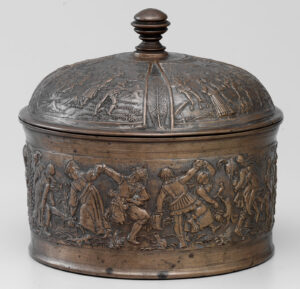
From Spanish soup to potpourri
Spanish soup was once the ultimate in Sunday meals. This stew was cooked and served in bronze tureens. The dish and its tureen have disappeared from our culinary consciousness. Only a few robust museum pieces and the foreign word potpourri remain as reminders.
Spanish soup is a stew that was popular throughout southern Germany and in north-eastern Switzerland in the 16th and 17th centuries. Before church on Sunday, this precooked dish was placed on the hot embers in the hearth or in the tiled stove in an often richly ornate bronze tureen, where it would simmer for one and a half to two hours. One advantage of this old cooking technique was that the maid could also go along to hear the sermon.
The main ingredients were blanched cabbage and precooked chestnuts, slices of cooked ham, lean bacon or smoked pork loin, little parboiled veal sausages, veal and sweetbread or beef escalopes, and so on. Up to ninety different ingredients are recorded in the old recipes. Vegetables and meat were placed in the pot in layers, and meat broth was poured on top. The knob of the heavy lid of the bronze tureen contained a hole to allow the steam from the dish to escape as it simmered in the stove.
Olla podrida
As the name suggests, this practical stew, perfectly suited to the limited kitchen facilities of the time and the Sunday routine, comes from Spain. Olla podrida found its way to the court of Vienna as olio soup, to France as pot pourri and to north-eastern Switzerland as Spanish soup, at around the same time as Spanish fashion began to spread throughout Europe. The Spanish name olla podrida means something like rotten pot in the sense of long-cooked pot. Presumably, the name given to the Spanish national dish of the Early Modern period involves a misunderstanding. It was probably originally meant to be simply an olla poderida, a powerful pot. The name, misconstrued in Spain itself as a rotten pot, was then translated literally by the French as pot pourri. Given the many different ingredients, the French name for the stew also acquired the transferred meaning of mishmash and ultimately potpourri in the sense of a musical medley.
The cooking pot as a status symbol
The often richly ornate Spanish soup tureens simultaneously served as a cooking pot, table decoration and status symbol. They were produced in the harbour, bell and cannon foundries of the time, such as Füssli in Zurich and Schalch in Schaffhausen. As the strict moral mandates in Protestant cities like Zurich, Schaffhausen and Basel left little room for entertainment and representation, these were civil objects of prestige of the highest quality and popular gifts of honour by newly elected leaders to their guilds and associations. A fine example of this is a tureen, probably cast in Schaffhausen in 1614, from the Herrenstube, a guild now known as the Zunft zum Kleeblatt, in Stein am Rhein with the coats of arms in relief and the names of the former guild masters Beat Böschenstein, Hanss Jacob Graaff and Joss Hubenschmidt. Needless to say, the newly elected masters not only produced the Spanish soup tureen but also arranged for a lavish celebratory meal to be served up when they took up office.





